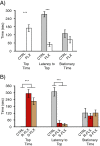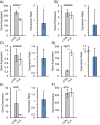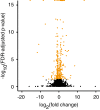Behavioral and neurogenomic transcriptome changes in wild-derived zebrafish with fluoxetine treatment
- PMID: 23706039
- PMCID: PMC3667115
- DOI: 10.1186/1471-2164-14-348
Behavioral and neurogenomic transcriptome changes in wild-derived zebrafish with fluoxetine treatment
Abstract
Background: Stress and anxiety-related behaviors are seen in many organisms. Studies have shown that in humans and other animals, treatment with selective serotonin reuptake inhibitors (e.g. fluoxetine) can reduce anxiety and anxiety-related behaviors. The efficacies and side effects, however, can vary between individuals. Fluoxetine can modulate anxiety in a stereospecific manner or with equal efficacy regardless of stereoisomer depending on the mechanism of action (e.g. serotonergic or GABAergic effects). Zebrafish are an emerging and valuable translational model for understanding human health related issues such as anxiety. In this study we present data showing the behavioral and whole brain transcriptome changes with fluoxetine treatment in wild-derived zebrafish and suggest additional molecular mechanisms of this widely-prescribed drug.
Results: We used automated behavioral analyses to assess the effects of racemic and stereoisomeric fluoxetine on male wild-derived zebrafish. Both racemic and the individual isomers of fluoxetine reduced anxiety-related behaviors relative to controls and we did not observe stereospecific fluoxetine effects. Using RNA-sequencing of the whole brain, we identified 411 genes showing differential expression with racemic fluoxetine treatment. Several neuropeptides (neuropeptide Y, isotocin, urocortin 3, prolactin) showed consistent expression patterns with the alleviation of stress and anxiety when anxiety-related behavior was reduced with fluoxetine treatment. With gene ontology and KEGG pathway analyses, we identified lipid and amino acid metabolic processes, and steroid biosynthesis among other terms to be over-enriched.
Conclusion: Our results demonstrate that fluoxetine reduces anxiety-related behaviors in wild-derived zebrafish and alters their neurogenomic state. We identify two biological processes, lipid and amino acid metabolic synthesis that characterize differences in the fluoxetine treated fish. Fluoxetine may be acting on several different molecular pathways to reduce anxiety-related behaviors in wild-derived zebrafish. This study provides data that could help identify common molecular mechanisms of fluoxetine action across animal taxa.
Figures




Similar articles
-
Effect of Early-Life Fluoxetine on Anxiety-Like Behaviors in BDNF Val66Met Mice.Am J Psychiatry. 2017 Dec 1;174(12):1203-1213. doi: 10.1176/appi.ajp.2017.15121592. Epub 2017 Oct 31. Am J Psychiatry. 2017. PMID: 29084453 Free PMC article.
-
Understanding complex dynamics of behavioral, neurochemical and transcriptomic changes induced by prolonged chronic unpredictable stress in zebrafish.Sci Rep. 2020 Nov 17;10(1):19981. doi: 10.1038/s41598-020-75855-3. Sci Rep. 2020. PMID: 33203921 Free PMC article.
-
Behavioral destabilization induced by the selective serotonin reuptake inhibitor fluoxetine.Mol Brain. 2011 Mar 16;4:12. doi: 10.1186/1756-6606-4-12. Mol Brain. 2011. PMID: 21410937 Free PMC article.
-
The age-dependent effects of selective serotonin reuptake inhibitors in humans and rodents: A review.Prog Neuropsychopharmacol Biol Psychiatry. 2011 Aug 1;35(6):1400-8. doi: 10.1016/j.pnpbp.2010.09.013. Epub 2010 Sep 25. Prog Neuropsychopharmacol Biol Psychiatry. 2011. PMID: 20883714 Review.
-
Fluoxetine during pregnancy: impact on fetal development.Reprod Fertil Dev. 2005;17(6):641-50. doi: 10.1071/rd05030. Reprod Fertil Dev. 2005. PMID: 16263070 Review.
Cited by
-
Molecular pathways associated with the nutritional programming of plant-based diet acceptance in rainbow trout following an early feeding exposure.BMC Genomics. 2016 Jun 13;17:449. doi: 10.1186/s12864-016-2804-1. BMC Genomics. 2016. PMID: 27296167 Free PMC article.
-
Lactobacillus plantarum attenuates anxiety-related behavior and protects against stress-induced dysbiosis in adult zebrafish.Sci Rep. 2016 Sep 19;6:33726. doi: 10.1038/srep33726. Sci Rep. 2016. PMID: 27641717 Free PMC article.
-
Integrative multi-omics landscape of fluoxetine action across 27 brain regions reveals global increase in energy metabolism and region-specific chromatin remodelling.Mol Psychiatry. 2022 Nov;27(11):4510-4525. doi: 10.1038/s41380-022-01725-1. Epub 2022 Sep 2. Mol Psychiatry. 2022. PMID: 36056172 Free PMC article.
-
Crafting Carbazole-Based Vorinostat and Tubastatin-A-like Histone Deacetylase (HDAC) Inhibitors with Potent in Vitro and in Vivo Neuroactive Functions.ACS Omega. 2019 Oct 7;4(17):17279-17294. doi: 10.1021/acsomega.9b01950. eCollection 2019 Oct 22. ACS Omega. 2019. PMID: 31656902 Free PMC article.
-
Developmental Neurotoxicity of Environmentally Relevant Pharmaceuticals and Mixtures Thereof in a Zebrafish Embryo Behavioural Test.Int J Environ Res Public Health. 2021 Jun 22;18(13):6717. doi: 10.3390/ijerph18136717. Int J Environ Res Public Health. 2021. PMID: 34206423 Free PMC article.
References
-
- American Psychiatric Association. Diagnostic criteria from DSM-IV-TR. Washington, D.C: American Psychiatric Association; 2000.
-
- Durant C, Christmas D, Nutt D. The pharmacology of anxiety. Curr Top Behav Neurosci. 2010;2:303–330. - PubMed
-
- Jacobson LH, Cryan JF. Genetic approaches to modeling anxiety in animals. Curr Top Behav Neurosci. 2010;2:161–201. - PubMed
-
- Westenberg HG. Recent advances in understanding and treating social anxiety disorder. CNS Spectr. 2009;14:24–33. - PubMed
Publication types
MeSH terms
Substances
Grants and funding
LinkOut - more resources
Full Text Sources
Other Literature Sources
Molecular Biology Databases

